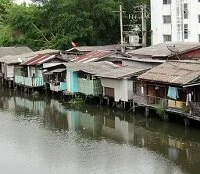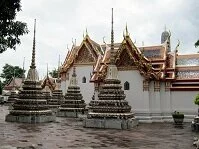Architecture of Thailand

River Housing
Thailand's architectural history is somewhat short since few early buildings have survived to the present. Of these early buildings, most were small temples or houses. Most of these early constructions were built from wood and have no lasted to the present. The houses, especially in the south along the coasts were generally built on stilts and had large windows or openings to maintain a cool temperature.
Due to this lack of early architecture, for the traveler, Thailand's architectural history doesn't truly begin until the 1200s with the construction the city of Ayutthaya. The architecture from this city influenced nearly all later Thai architecture, most particularly the stupas (funerary monuments) and other Buddhist monuments.

Wat Pho
The stupas in Ayutthaya are what is commonly associated with Thai architecture today as the bell-shaped stupas are circular and stretch into the sky. This complex consists of numerous stupas and other buildings that serve the capital city at the time. Nearly all of the buildings here were made from bricks and plaster, a tradition that continued on in later buildings throughout the country.
Shortly after Ayutthaya rose to prominence, so too did Chaing Mai, which took much of their architecture from Ayutthaya, but continued the development of the style through the 1400s and beyond. Among the numerous architectural wonders in Chaing Mai, the Wat Chet Yot is among the most impressive.